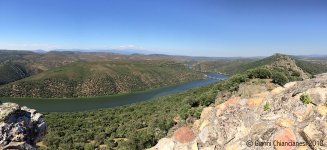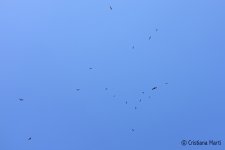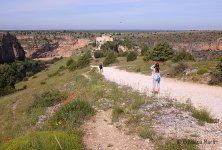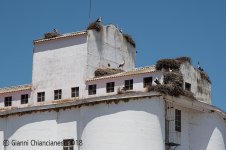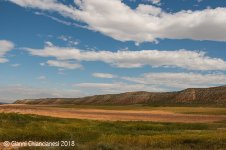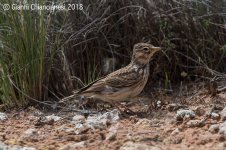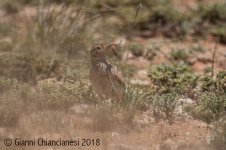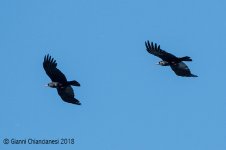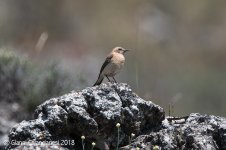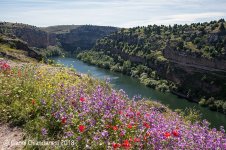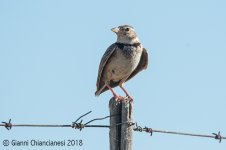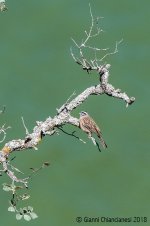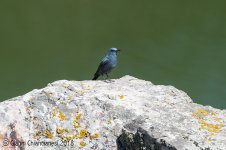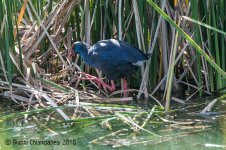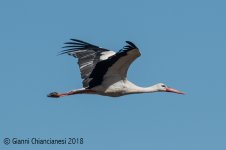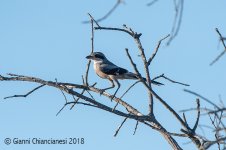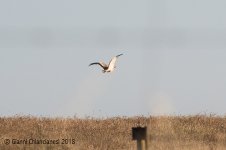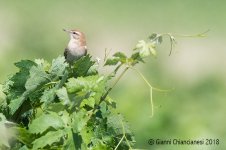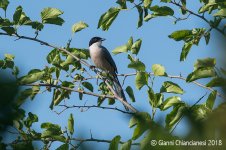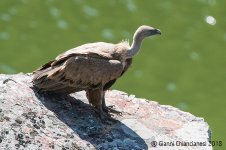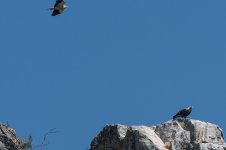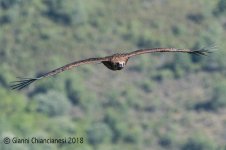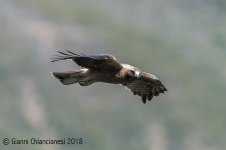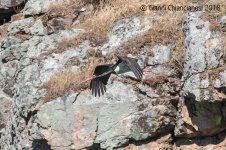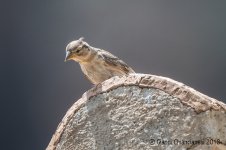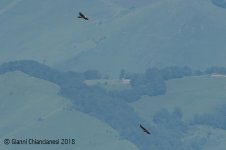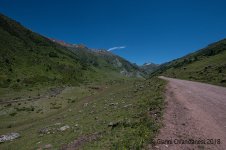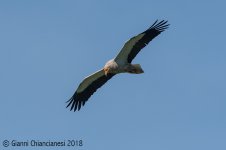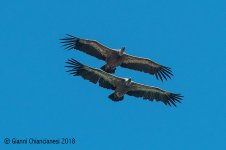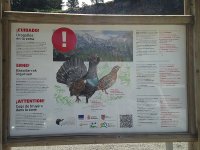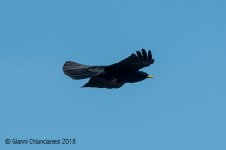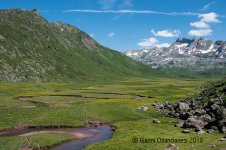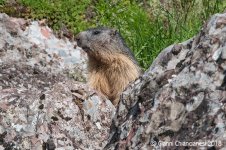
After three summer holidays in cool to cold climates, Sweden, British Columbia and Scotland, this year we opted for a change and chose Spain, targeting two main areas: Extremadura (although we knew that it wouldn’t be the best time to visit) and the Central Spanish Pyrenees.
We drove, taking the ferry to Barcelona on the outward journey and leaving the long drive for the return trip, with stopovers planned in the French Alpilles and Genoa. The planning of the actual itinerary in Spain was a long and painful process, and eventually we had to give up on several targets as we realised that we wouldn’t have time to see everything.
From Barcelona we drove west to Extremadura, stopping at Belchite and at the Hoces del Duratón to try for Dupont’s and Lesser Short-toed Larks. We then spent a week or so in Extremadura (we had planned a day trip to the Sierra de Gredos for Bluethroat, but then left it for “another time”), then drove north to the Pyrenees with another 5-6 days there before heading to the Alpilles, where we have a friend, and home.
As for accommodation, apart from the one night on the ferry, we used hotels from a well-known French budget chain for the shorter stays, a “Casa Rural”, run by a birding guide in Extremadura, and a mountain hotel in the Pyrenees.
We read a lot of literature on the web, Birdforum included, spoke to friends who had been there before us and to friends who live in Spain, and we also purchased The Gosney’s guide for Extremadura (the latest edition also includes the Sierra de Gredos area) and “Where to watch birds in Northern and Eastern Spain”. Our field guide was the latest Italian edition of the trusted Collins.
We saw all our main targets, excluding Bonelli’s Eagle which we didn’t really waste much time on given that we thought “oh well we can always see it in the Alpilles” (we had seen it every day during our last trip there in 2015) As it turned out, our friend from the LPO told us that this year the breeding season for Bonelli’s in the Alpilles had been a total disaster with no new young eagles fledged, and as it was already late in the season the adults had dispersed, making it extremely difficult to spot one during such a brief stopover.
We also only heard Pin-tailed Sandgrouse and didn’t see Little Bustard, but the heat made it very difficult to connect with the steppe species, so we were very glad with what we had managed to see (and we had seen Little Bustards very well in the above trip in 2015). We also saw species which we thought would be extremely difficult, such as Black Wheatear and Rufous-tailed Bush Robin, but saw less of what we thought would be more obvious, struggling to connect with i.e. Black-shouldered Kite because of the extreme heat during the day.
Towards the end of the trip we also gave up on trying to look for some species as we were getting tired after around 4000 kms on the road (the total would be just over 5000 when we got home), but altogether it was a memorable trip, with a checklist of 150 species, which we were very happy with, given the late timing of the trip.
We also didn’t see Red-necked Nightjar, but didn’t really try too hard. What surprised us most though was that we couldn’t see a single Montagu’s Harrier. It wasn’t a priority as we have them here, but it just felt odd, as some of the places we visited looked very well suited for Montys. How common are they? Just wondering. It was also a shame that the two fleeting observations of Green Woodpecker were only seconds long and always from the back, so we couldn’t really appreciate the difference with “our” Green Woodys.
Ubiquitous species (therefore not always mentioned): White storks (apart from the Pyrenees), Griffon Vultures (everywhere), Black Kites, Crested/Thekla Larks (not in the Pyrenees), Chaffinch in the Pyrenees.
We drove, taking the ferry to Barcelona on the outward journey and leaving the long drive for the return trip, with stopovers planned in the French Alpilles and Genoa. The planning of the actual itinerary in Spain was a long and painful process, and eventually we had to give up on several targets as we realised that we wouldn’t have time to see everything.
From Barcelona we drove west to Extremadura, stopping at Belchite and at the Hoces del Duratón to try for Dupont’s and Lesser Short-toed Larks. We then spent a week or so in Extremadura (we had planned a day trip to the Sierra de Gredos for Bluethroat, but then left it for “another time”), then drove north to the Pyrenees with another 5-6 days there before heading to the Alpilles, where we have a friend, and home.
As for accommodation, apart from the one night on the ferry, we used hotels from a well-known French budget chain for the shorter stays, a “Casa Rural”, run by a birding guide in Extremadura, and a mountain hotel in the Pyrenees.
We read a lot of literature on the web, Birdforum included, spoke to friends who had been there before us and to friends who live in Spain, and we also purchased The Gosney’s guide for Extremadura (the latest edition also includes the Sierra de Gredos area) and “Where to watch birds in Northern and Eastern Spain”. Our field guide was the latest Italian edition of the trusted Collins.
We saw all our main targets, excluding Bonelli’s Eagle which we didn’t really waste much time on given that we thought “oh well we can always see it in the Alpilles” (we had seen it every day during our last trip there in 2015) As it turned out, our friend from the LPO told us that this year the breeding season for Bonelli’s in the Alpilles had been a total disaster with no new young eagles fledged, and as it was already late in the season the adults had dispersed, making it extremely difficult to spot one during such a brief stopover.
We also only heard Pin-tailed Sandgrouse and didn’t see Little Bustard, but the heat made it very difficult to connect with the steppe species, so we were very glad with what we had managed to see (and we had seen Little Bustards very well in the above trip in 2015). We also saw species which we thought would be extremely difficult, such as Black Wheatear and Rufous-tailed Bush Robin, but saw less of what we thought would be more obvious, struggling to connect with i.e. Black-shouldered Kite because of the extreme heat during the day.
Towards the end of the trip we also gave up on trying to look for some species as we were getting tired after around 4000 kms on the road (the total would be just over 5000 when we got home), but altogether it was a memorable trip, with a checklist of 150 species, which we were very happy with, given the late timing of the trip.
We also didn’t see Red-necked Nightjar, but didn’t really try too hard. What surprised us most though was that we couldn’t see a single Montagu’s Harrier. It wasn’t a priority as we have them here, but it just felt odd, as some of the places we visited looked very well suited for Montys. How common are they? Just wondering. It was also a shame that the two fleeting observations of Green Woodpecker were only seconds long and always from the back, so we couldn’t really appreciate the difference with “our” Green Woodys.
Ubiquitous species (therefore not always mentioned): White storks (apart from the Pyrenees), Griffon Vultures (everywhere), Black Kites, Crested/Thekla Larks (not in the Pyrenees), Chaffinch in the Pyrenees.
Attachments
Last edited:




